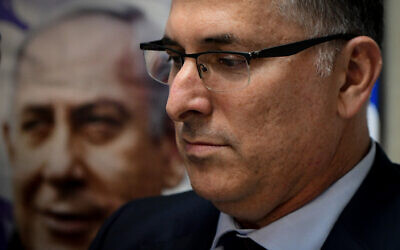Of the dozen or so parties forecast to enter the 24th Knesset after the March 23 election, only one is headed by a woman.
That’s still one more female-led party than in the last election, less than a year ago. The Knesset remains very much a man’s world, but several party slates show women in senior positions and herald what could be a record-breaking level of female representation.
MK Merav Michaeli, who won the Labor leadership primary late last month, is not just a party head who happens to be a woman smashing a low-set glass ceiling in a sea of male-dominated politics. Rather she is a lifelong feminist activist who has become an icon for others, who see in her the coming of a gender-equality renaissance in the Knesset.
Michaeli’s rise to power has helped re-energize Labor after years in which it has had one foot in the political grave. She’s the third woman to lead the party that was once a cornerstone of Knesset politics. The first, Golda Meir, went on to become Israel’s only female prime minister. The second, Shelly Yachimovich, led the opposition and helped rehab the party after it was torn asunder by former leader Ehud Barak refusing to leave the government.
Michaeli’s party is polling at between six and seven seats, a major jump from the zero it was getting just a few weeks ago, but it’s safe to say for now she’s more likely to follow Yachimovich’s footsteps than Meir’s.

Merav Michaeli, center, taking a selfie at a Labor party conference in Tel Aviv on January 22, 2019. (Flash90)
Should Prime Minister Benjamin Netanyahu manage to form another government after the election, Michaeli and Labor will go to the opposition, which is where she camped herself during the 23rd Knesset, even after the rest of her party bolted for Netanyahu’s coalition.
But even from the sidelines, Michaeli has managed to have a broad impact on Israeli politics, at least partially thanks to her clear messaging on gender issues.
Her first announcement as Labor chief was a commitment to keep the party’s list of candidates gender-balanced, going beyond the 40% quota for female representation favored in Sweden and some other places. Instead, she vowed to have five women in the first 10 slots, a promise she came through on when the party submitted its slate on Thursday.
If the party manages to get to seven seats, it will have four women in the Knesset, the only party with more women than men.
Three other party leaders have made a point of making sure the top echelons of their faction rosters are stocked with multitudes of female candidates: Yesh Atid’s Yair Lapid, New Hope’s Gideon Sa’ar and Yamina’s Naftali Bennett. The three are also among the six parties that have a female co-pilot, along with Meretz, Religious Zionism and Blue and White.
All three are considered to be hip to the importance of feminism in politics. Lapid was the first-ever finance minister to have a female treasury director. Sa’ar was the first male MK to chair the Knesset Committee for the Advancement of Women and Gender Equality back in 2007. (When another man, Oded Forer, was tapped to head the committee last year, he faced an expected backlash.) Bennett regularly takes pride in his former business partner Michal Tsur — one of his co-founders at Cyota — and has worked closely with Ayelet Shaked, who split off with him to form the faction that eventually became Yamina.
Yesh Atid, which has promised to keep its list at least 40 percent female, boasted last week that its list of candidates was evenly split between women and men. Three of the four candidates following Lapid on the slate are female, though they become scarcer immediately after that.
The parity is achieved only by having women heavily outrank men lower on the slate, with no chance that they will actually make it into the Knesset. Of the final 20 names out of 120 the party submitted, at least 16 are female.

Knesset members Miki Haimovich and Meirav Cohen in the Knesset on April 29, 2019. (Noam Revkin Fenton/Flash90)
In actuality, there is little chance it will hit the 40% threshold if only counting those who will become Knesset members. The party is polling at 16-18 seats; if it wins 18 seats, six of them will be female — 33%. Should it drop to 16 seats, it will have only four females — 25%. But if it makes it to 20 seats, eight will be held by female candidates — 40%.
Sa’ar’s New Hope has two women in his top five and four in his top 10. The party is polling at between 14 and 16 seats. If he gets to 16 seats, he’ll have five female MKs — 31%. If he falls to 14 seats, he’ll only have four females — 29%.

From left to right: Naftali Bennett, Ayelet Shaked, and Bezalel Smotrich, at a campaign event in the West Bank settlement of Elkana on August 21, 2019. (Ben Dori/Flash90)
Bennett’s Yamina only has one woman, Shaked, in its top five and three in its top 10, though it squeezes in eight potential female lawmakers in its top 20. However, the party is forecast to only get 11-12 seats if elections were held today. If it gets 12, it will have four female MKs — 33%. But if it falls to 11, it will only have three — 27%.
Likud, like Labor, has primaries, so customizing slates for gender equality is not as simple, but Prime Minister Benjamin Netanyahu has taken notice of the way the winds are blowing and used two of the reserved slots he is afforded to place more women on the party slate.
He placed author and commentator Galit Distel Atbaryan at number 10, and granted MK Orly Levy-Abekasis, who has journeyed to and fro across the political spectrum since splitting off from Yisrael Beytenu, the 26th place.
Likud’s registered slate has one woman in its top five — Miri Regev — and three in its top 10, including Distel Atbaryan. Polls have shown the party getting 29 seats in the election, which would place seven women in the Knesset — 24%. Far from equal, but about par for the course for the Knesset.
The Joint List, a combination of three different Arab parties, has one woman in its top five and three women in the top 10.

Joint List MK Heba Yazbak shakes hands with Blue and White MK Benny Gantz at the Knesset on May 13, 2019. (Noam Revkin Fenton/Flash90)
The party is polling at around nine seats, and all three would make it in if it indeed wins all nine, making its Knesset faction 33% female.
Avigdor Liberman’s Yisrael Beytenu also has only one woman in its top five, and she holds the fifth spot. There are three women in the top 10, but the party is only expected to get seven seats, which would mean only the one female MK.
Meretz, a traditionally gender-balanced party, has two women MKs in its top five, and five women in its top 10. The party is polling at four seats, which would give it two female MKs.
Bezalel Smotrich’s Religious Zionism slate, which includes the Kahanist Otzma Yehudit and anti-gay Noam parties, also has two women in its top five. The party is polling at around four seats, though, meaning only one woman would make it in.
Like Religious Zionism, Defense Minister Benny Gantz’s Blue and White party is also hovering around the 3.25% vote threshold to enter the Knesset. It also has two women in its top five, and if it squeezes in with four seats, one of them will enter the Knesset.
Raam, an Islamist party that split off the Joint List, is not currently expected to enter the Knesset, and even if it pulls off the upset and gets in with four seats, it won’t be enough for its lone female candidate in the top five.
Don’t bother trying to count how many women are highly placed in ultra-Orthodox parties Shas or United Torah Judaism. There aren’t any, anywhere on their slates. Both parties have strict policies against female lawmaking.
By conservative polling estimates, as they stand now, 30 women would be sworn in for the 24th Knesset, matching the record 30 women who were sworn in a year earlier for the 23rd Knesset.
But polls also show that a Knesset with 34 women being sworn in is well within the realm of possibility. The number would mean a measly 28.3% female representation, but would still be the first time they broke the halfway mark towards the 60 seats that would reflect true equality.

MKs stand for a moment of silence at a memorial ceremony marking 24 years since the assassination of prime minister Yitzhak Rabin on November 10, 2019. (Yonatan Sindel/FLASH90)
Still, the 24th Knesset is expected to have 30 female MKs in all, alongside 90 male MKs. The number will represent a measly one-quarter of the legislature’s 120 members.
In 2019, the International Parliamentary Union ranked Israel 54th in the world in terms of gender parity among lawmakers. In 2020, Israel had two more female Knesset members elected than the second vote in 2019, yet it dropped all the way down to 83 on the IPU ranking.
What changed? The world.
 RSS Feed
RSS Feed















 February 10th, 2021
February 10th, 2021  Awake Goy
Awake Goy 


 Posted in
Posted in  Tags:
Tags: 













